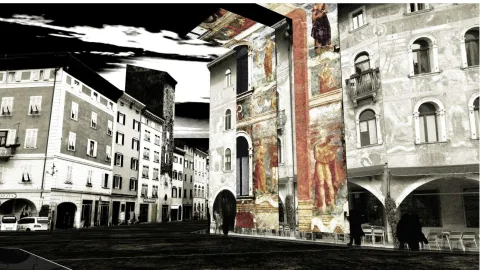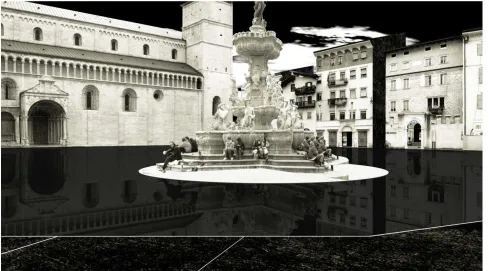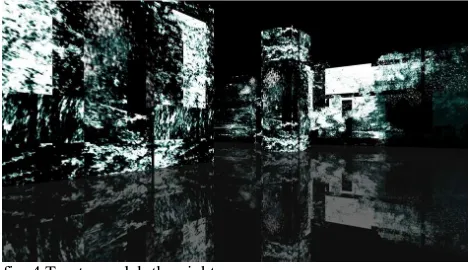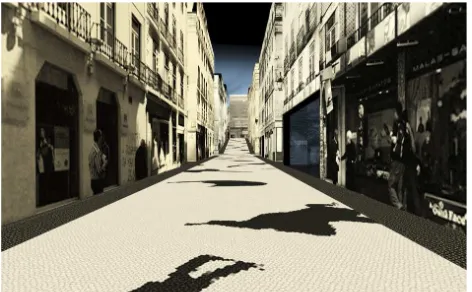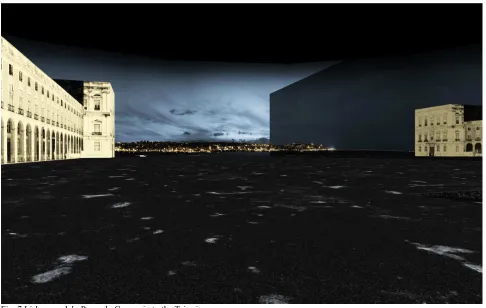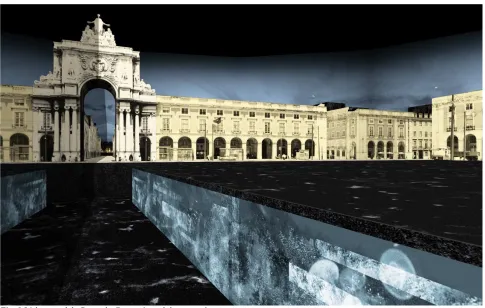KEY WORDS: Virtual environment, 3D interactive model, virtual game
ABSTRACT:
MIC is an EU funded project to explore the use of shared virtual environments as part of a public discussion on the issues of building the city of the future. An interactive exploration of four european cities – in the digital city models were translated urban places, family problems and citizens wishes – is a chance to see them in different ways and from different points of view, to imagine new scenarios to overcome barriers and stereotypes no longer effective. This pap er describes the process from data to visualization of virtual cities and, in detail, the project of two interactive digital model (Trento and Lisbon).
1. INTRODUCTION
1.1 MIC project
MIC is an EU funded project to explore the use of shared virtual environments as part of a public discussion on the issues of building the city of the future. The project involves four science museums – Trenton, Lisbon, Copenhagen and Jerusalem – and MeLa Multimedia Lab of University IUAV of Venice, which was responsible for the artistic coordination and implementation of part of the virtual environments*
.
The initiative crosses themes and skills of social research, archi -tectural and urban design, public administration and technology in an interactive exploration of four cities, now visiting on web (www.myidealcity.eu) and on the exhibitions in the four mu-seums of the consortium.
The translation of places and family problems into a new medi-um is a chance to see them in different ways and from different points of view, to imagine new scenarios to overcome barriers and stereotypes no longer effective. Virtual environments are an ideal starting point for a 'game' serious simulation and imagina-tion applied to social relaimagina-tions that have as background the city scene, in particular those between the different categories of population.
* The MIC project was funded by European Community’s Seventh Framework Programme, under Grant Agreement n. 230554. The project was created by Carlo Maiolini and Maurizio Teli (Museo Tridentino di Scienze Naturali), coordinated by Denise Eccher, Carlo Maiolini, Maur-izio Teli (Museo Tridentino di Scienze Naturali) under the supervision of Michele Lanzinger – CEO and Lavinia Del Longo (Museo Tridentino di Scienze Naturali). It was developed by Bloomfield Science Museum Jerusalem; Ciencia Viva, Lisbon; Experimentarium, Copenhagen; Museo Tridentino di Scienze Naturali, Trento; Università IUAV di Venezia. Art direction: Malvina Borgherini and Emanuele Garbin – Uni-versità Iuav di Venezia. Prrogramming and virtual platform: Virtual Italian Parks, Roma – Moondus.
The project and model of Trento and Lisbon are developed by MeLa Laboratorio Multimediale Iuav (scientific director Malvina Borgherini); chief project: Emanuele Garbin; team project: Emanuele Garbin and Malvina Borgherini with Eufemia Piizzi, Luciano Comacchio, Margherita Marrulli, Silvia Spinelli (IT consulting Alessandro and Marco Forlin).
The four cities involved represent four very different variations of the same idea of cities dialectics: European and Mediter-ranean, old and new, real and virtual, rigid and at the same time changing. In this complexity, which represent the city of MIC, is possible to recognize a character and an identification of the most valuable assets of the same European culture.
1.2 From data to visualization
Understanding and reflecting the participants point of view was essential, therefore abstractions had to be carried on carefully in order to turn them into a model that reflected the point of view of the participants. The situation resembles that of the client and the architect. The moderator must take the role of the architect and give the best possible answer to the demands and wishes as seen in the words of the client.
The translation draw on existing typologies and textures – re-arranging, re-scaling or re-combining them into new urban spaces. This method ensures a clear reference to the local context.
Finally the translation was positively related to some principles proposed by art direction of the MIC-project that ensured some degree of homogeneous approach of the different cities needed for the final user to make the comparison.
The general principles previously formulated for the virtual city project are:
– the image of the virtual city should be characterized by a keen visionary force and a compelling power of attraction
– the image of the virtual city should be purified of any visual stereotypes that tend to blight such interactive worlds (avoiding hackneyed solutions derived from video games and film like Star Wars, Alien, Blade Runner)
– metaphor-guide narratives and original visuals are necessary – the model-making work should be subordinate to creativity and the project overall
fig. 1 Trento model: the old town centre and a frescoed facade
– creativity may take form by incorporating text fragments, speech, voices, images, slogans and ideas issuing from the focus group
– the aim is to construct something similar to reality rather than a preliminary maquette
– the avatar should always move within the natural internal bounds of the model-scene which ought never to be seen from the outside or above.
– the virtual city should echo the actual city but not be a brick-for-brick duplicate: not only may creative licence aid the model's functionality, it may additionally be viewed as a golden opportunity to explore geometrical and to some extent topological options in a more liberated manner.
– symbolic elements may well be call on for recognition and identification (certain facades, roads, squares instanced from the actual city)
– furthermore these symbolic elements may also undergo manipulation.
The participatory process organised produced a certain form of material that cannot be directly inserted into the 3D models: this mostly relates to transcribed or summarised thoughts and opinions expressed by the different social category groups interviewed.
Especially in the cases of Trento and Lisbon this material, from which literal citations, catchwords or particularly significant themes were subsequently extracted, was then transformed into images or scenes characterizing not only in the real part but also the ideal part of the virtual city.
The literal citations, treated like images in the form of graffiti on the walls of the town, were introduced in the model as visual or even acoustic expressions issuing directly from the persons interviewed and thus perfectly recognizable by their authors. The particularly significant catch phrases or themes characterized the formal outcome of the models from the start.
2. THE DIGITAL MODELS
2.1 General settings
For technical reasons the maximum area available for each model city is about nine hectares. These factors had indeed in-fluenced the model designs (especially Trento, Lisbon and Jeru-salem), ushering in the application of synecdoche – a part rep-resenting a whole – an essential device. A sequence of urban fragments may therefore be composed in a unique way to rep-resent the individual city (not necessarily corresponding geo-metrically or topologically to reality, but strongly connoted by some of the present buildings and so instantly recognizable). It is fundamental that the resulting city is recognizable (identity, memory as “locations” where there is a reflection on complex-ity, on stratification and on a delineation of the bounds of a col-lective unconscious) and at the same time clearly shows courses towards one's own transformational propensities (identity, inter-action in the sense of an awareness of one's ability to implement change).
The models are therefore characterized by an evident heterogen-eity between the parts (for example the old town centre of Trento is dissimilar to that of Piedicastello or Canova or Pove) marked through a complexity of maps, direct quotes from the “skin” of the town (in white and black) or insertions of new im-ages (in colour), treated in a different manner so as to obtain different levels of consideration (coloured elements contrast ob-viously against a grey uniform background which indicate nov-elty or – in the case of Trento – to extremely significant histor-ical details like the painted facades).
fig. 2 Trento model: the cathedral in the old town centre
2.2 Trento model
In Trento, the overall project path has been significantly affected by a social science approach, that brought, first of all, toward the use of focus groups and ethnography, as the tools to elicit input for the elaboration of the concepts behind the “Ideal City”. As underlined in other Deliverables, in Trento we focused on four different areas of the city:
1. the historical centre, with its inherent mixing of different cultures and practices
2. Piedicastello, an historically working class area on the right of the Adige River, in the west of the cities
3. Canova di Gardolo, a peripheral area in the north of Trento
4. Povo, a bourgeois area in the Eastern hills, with a strong feeling of being a town “on its own”
Summarizing, in Povo the main method of data gathering was an urban ethnography, carried on by a local ethnographer, and the data has been summarized by her through the tools of an-thropological research.
Povo is the only part of the town fully satisfied with its own situation: it has a salubrious relation with the surrounding land-scape, quite well connected to the centre and is composed of a loose hub of mostly detached family residences immersed in greenery. The most fitting device for its representation seemed to be through a series of rooms in which the landscape was con-tained.
In the other parts, the focus group has been the main technique. In those cases, the focus groups have been transcribed and then analysed, through Grounded Theory. The analysis was carried on with an open coding based on a paragraph by paragraph ap-proach, followed by an axial coding collecting the categories created into a smaller subset (if we had 150 categories during
the open coding, we ended up with 13 categories after the axial coding).
The old town centre is seen as a fundamental reference location for the different areas of the town, being the zone that all the other parts of Trento constantly refer to. Just by virtue of its very homogeneousness, the old centre is the zone in which most of today's conflicts are concentrated (young / old, daytime town / night-time town, migrating / permanent, students / townspeople, new/old etc.). These are the contrasts that the vir-tual town seeks to unveil.
The salient feature of the model of this area is the polarisation between the external facades on the central roads and those of the internal courtyards. The external facades – often frescoed with trompe l' oeil, caricatures, events, emblems of life past – constitute Trento's palimpsest, on which the ongoing life of the town have been traced and transcribed through the ages, presently consolidated into its most identifiable and almost in-variable aspect. What really does change continuously in the ac-tual town are the internal courtyards and ground floors that are designated for commercial activities (the shop – il negozio –
mentioned previously).
In the model the external facades correspond to the present day prospect (only their chromatic aspect has been altered, unifying them into a white-black monotone that contrasts with occasional colour, employed to highlight some historical example of spe-cial significance or to indicate access); however great licence has been exercised in rendering the internal courtyards and they bear no geometrical or topological relation to actuality.
fig. 3 Trento model: the accesses to the rooms
– the new / old conflict room, in which examples of new and old skins (here represented by the architectural surfaces of temporary buildings; glass, steel and cement serigraphs, in con-trast to columns and mouldings of marble, age-worn timbers), yet also where relevant graffiti that calls for the cancellation of new parts of the town will be shown (“Madonna Bianca in the '70s bore monsters. There's 12-13”, “my ideal town would be without those abandoned monsters” – here the reference is dir-ected at the former cement works – “LET'S KNOCK 'EM DOWN!”);
– the migrating / permanent conflict room where the relations between non-EEC newcomers and indigenous townsfolk (“poor devils after all”, “we had coffee speaking by way of gestures”) and the relations within a town that has recently undergone rad-ical change (“in Piazza Dante you just had a few clochards
who'd amble on after an offered cigarette and glass of wine, but today the problems have taken a turn for the worst”);
– the young / old, student / towny, night-life / daytime conflict rooms with all the characteristic intolerance and contradiction (“here they put in eight hours work and sixteen hours sleep, if you have a party they call the police, if you hang out a while in the park along come the police. They pretty much confine you to go to bed!”, “University town? Well, the young are around. We give them the opportunity to enjoy themselves!”, “I'll kick it off with a bucket of water thrown from my upstairs window”). The major part of Piedicastello – the district of Trento on the other side of the the Adige river where the ancient town settle-ment was situated beneath the mountain – is occupied by an edi-fice (the former cement works) which will undergo a radical and unexpected transformation. It is interesting that from this zone, so strongly characterised by the former cement works' presence, there is no visual connection with the “monster” while the centre of Trento is clearly in view.
One adjunct wing of the old centre is placed in this part of the model, the bridge that connections it with the old town centre (the reference, as resolved by the focus group, is the Bocchi project of the 1980s of a bridge populated by shops and com-mercial activity, rather like Venice's Rialto Bridge or Florence's Ponte Vecchio, with more of a visual opening onto the river), the second wing is the former cement works by the mountain. Specifically in this area there are two changeable environ-ments:
– the room containing the secret garden is characterised by an upward and labyrinthine path, in which one may enter an alley-way of one of the old centre's enclaves, this leads to the top of Dos Trento (originally named Mount Verruca by the Romans) – and which terminates, on reaching the Cesare Battisti monu-ment, with a panoramic visa encompassing the entire town of Trento;
fig. 4 Trento model: the night room
– the room for the former cement works is interpreted as a hol-low screen that summons up and displays the internal spaces, al-most a sort of counter-facade of the mountain. The screen is ac-cessible and will become an object to attain through a series of openings, stairwells, etc. This special place is destined to ac-commodate the much call for night-life aggregation hub for Trento. It is a place where to look and be looked at, where the young are observe from inside and from where the young can look out from.
Canova di Gardolo, a suburb about 5 km to the north of central Trento is characterised by a strong presence of non-EEC resid-ents and migrants, a rather spacious part of the town yet not so easily identifiable. Canova has no visual connection with the centre of Trento, nor does it have a wide-ranging view of the neighbouring landscape or the mountains, an imposing element that characterises the other districts of the town.
A conclusion was reached that two elements might be modified in order to mark a certain will to change in this zone:
– the piazza, allowing a circular introspective glance, in order to nurture the feeling of being part of a community;
– the tower, allowing for a panoramic vista, in order to reaffirm the visual connection with the centre of Trento.
It is symptomatic that the strongest request to emerged from the focus group in this zone (youngsters had asked for a statue of theirs to be placed in the centre of Canova) was the possibility to see themselves represented within the town, attest themselves in relation to Trento. The distance between Canova and Trento is not very far but is above all a visual void that needs to be re-plenished: this visual exclusion hinders a feeling of connection with Trento, prevents the Canova community from identify it-self with it.
2.3 Lisbon model
Fig. 5 Lisbon model: Baixa historical perpendicular road grid
It was decided that this should be the reference zone for the model of an actual/ideal Lisbon, making all converge in a single space and with particular stratagems including some other areas discussed in the focus group:
– Miradouro da Graça / Elevador da Bica
– Cais do Sodré / Cacilhas
– Ponte 25 de Abril / Docas,
– Castelo de São Jorge
– Torre de Belém.
A portion of Baixa, stretched out between the two extremes, the medieval labyrinthine dispersal and its geometrical orientation towards the sea, had been chosen which denoted a particular and appealing aspect to represent Lisbon, indeed these are the same determining factors when considering any virtual world. A division between sides/facades, as in Trento's case, is the base for the setting: the layout of a perpendicular road grid designed in the eighteenth-century redevelopment constitutes the recognisable face of Lisbon. To this is added the horizontal ground plane, with its typical black and white paving, a screen of ante litteram pixels.
The virtual model in some locations reopens the ground floors of individual blocks, making them permeable to an avatar's glance and personal interaction. It was thought best to use “rooms” with different themes and images in order to emphasise the differentiation of the grid mesh.
The city grid will be doubled along its longitudinal axis, for the positioning of a mirror at this juncture: both an optical/virtual device and an acknowledgement of the public. Some doors on the reflective surface will open up some passages in correspondence to roads that cross (emblematically used for the maze and the idea of discovery, in contrast with the longitudinal roads that symbolise orientation and the idea of return). The doors will lead on into “rooms”, the inside of which will represented those aspects, those features and conflicts that characterise the zones of the city that are distant from the centre, the new facets of Lisbon.
The new facets of Lisbon could be:
– its rapport with the river, rather the waterfront with all the new characteristics of the town and the aspects bound up with an economically sustainable use of the Tejo;
– its rapport with urban green spaces, particularly through the creation of a room that takes as its theme the gardens of the Gulbelkian foundation;
– the vistas which criss-cross the town, its miradores that are situated on the highest points overlooking Lisbon;
Fig. 6 Lisbon model: the historical facades room
– Its neglected rapport with the old town centre, via “rooms” dug into the eighteenth-century building blocks whilst re-utilising typical architectural and urban elements that represent Lisbon.
Here, as with Trento, the contemporary presence of an avatar triggers changes of light or the projections of images and video. This thus represents, by way of their own highly condensed collaboration, a type of emblem for an effective meeting and dialogue that could well go on to generate change in the actual city itself. This stratagem is the foundation and point of departure for the launch of a series of mini-games yet to be put into production.
3. MODELING CRITERIA
Design and modeling MIC worlds started from the decision to subordinate the entire workflow and every technical choice to the overall targets of the project.
From the beginning it was clear that the realization of multy-player networked and interactive environments would impose significant limitations regarding the size of the geometric and graphics contents. It was therefore decided to introduce a 'meta-phoric' mediation which was immediately detected in a ‘sceno-graphic’ metaphor.
If the MIC worlds – but in general any shared virtual world – should be able to contain heterogeneous sets of objects, a 'real-istic' metaphor is always inevitably inadequate, unable to match expectations. The theatrical tradition, in contrast to that of cine-matographic realism, proposes mechanisms of construction and exploration of virtual environments based on a certain suspen-sion of verisimilitude, an agreement between the author and his audience. A ‘theatrical’ metaphor, a scenographic approach to the modeling of virtual worlds allows degrees of freedom that broadly balance the technical limitations.
Fig. 7 Lisbon model: Praça do Comerçio to the Tejo river
In modeling worlds MIC we used three ingredients: basic pur-poses, leading metaphors and infographic instruments. The most important intention is to preserve the ‘depht’ of the urban im-age, considering that the depth of the urban 'face' or 'facade' is one of the essential characteristics of urban experience. And precisely the inability to perceive this complexity and richness is the main reason for the poor experience produced by many real and virtual places.
The realization of these urban scenes has preferred the modes of replacement, analogy, quotation to those of simple reproduction. In the spatial narrative of MIC’s worlds you can find many rhet-orical figures, particularly those of metaphor, metonymy, synec-doche. The recurrent condition is to have to represent the whole – the city, a square, a neighborhood, a common behavior, a social class – by his own single part – some facades, some em -blematic places, slogans or whatever. A non homogeneous re-duction of details has been preferred to a linear simplification so as to leave some elements of a complexity comparable to that of reality. The concept of Level of Detail (LOD) was completely rejected because it was considered that the visitor's attention should be able to instantly focus on a specific detail or open to a broad vision of a neighborhood only depending on the amp-litude of his visual field.
Characteristics of the virtual space and ways of exploring MIC’s cities are very similar to those of a stage set opened between the acts. It is as if the avatar could wander through the wings of pa-per and wood of a scene, indifferent rather curious and amazed by the spatial and visual incoherences that inevitably occur. Let’s describe some of the properties of these spaces and these movements. The most striking feature of the virtual urban spaces, compared with the real ones, is that of heterogeneity, or anisotropy.
The sizes and distances in virtual environments shrink, some blocks disappear or are reduced to a portion, the whole city is
represented by some districts: in the case of Trento an entire neighborhood is replaced by a cafè interior, in the case of Lis-bon a district composed on a regular and repetitive grid is re-duced in the number of its blocks. The distances between the parts of the city are reduced or vanish: between the districts of Trento virtual transfers are instantaneous and made possible by entering particular rooms. In the transition between the city of Trento and its suburb of Piedicastello this special portal is pre ceded by a contraction of the street that leads to it. The real ele -ments and those of ‘invention’ (or anticipations of a possible fu-ture) are recomposed into sets that retain some recognizable fea-tures and transform or remove inessential parts. None of these 'contractions' is the simple product of an automated task, but al-ways the result of a ‘narrative’ project.
Fig. 8 Lisbon model: Praça do Comerçio and the acquarium
The prevalence of pictures and textures over geometries derives from the premises declared at first. In the model, as in a painted scenery, solid structure acts as a simple support for the images. From the same preferences derives also the prevalence of a mapped environment made of photos rather than artificial or procedural images. The richness, the textures, the light of the real facades and landscapes get in the virtual cities as a photo-graphic quotation, as a luminous footprint. No matter of interest may be found in a procedural map, produced by the combina-tion of fractal geometries, as a procedural map can mimic the abundance and articulation of a real texture, but not its deep and inexhaustible complexity. On a real surface are layered visible traces of natural and human history, the ghosts of countless indi-vidual and collective stories never completely deciphered. For the same reason, when it was not possible or appropriate to cap-ture the actual map of a surface, it was decided to create a new texture from real items, founded within the same context: for example, in the case of the completely invented parts of Lisbon we used many photos of ‘azulejos’, a tipical blue tiles used for centuries in Portugal, and also photos of historical commercial inscriptions or details of vegetation from a well-known urban park. In a particular case we wanted to make this mechanism explicit by 'embedding' it in himself in a room of Lisbon: on the walls of this court some 'snapshots' taken by avatars during their exploration become maps of the model, and can be photo-graphed again.
In the image processing two processes only apparently contra-dictory are matching: after you have worked an ‘extraction’ of images, a direct acquisition of parts of visible reality, these im-ages undergo strong transformations, a process of ‘abstraction’. The action of desaturation, contrasting, applying grain or noise, blurring or dimming serves to widen the range of the possibilit-ies of interpretation that had been previously restricted by the 'reduction' implicit in the shooting. The raw photo shows the
'face' of the city on a certain day and at a certain time, but the photo processed gives the possibility to imagine a different one, and many others. In some parts of these models maps are made pulsing, by means of transitions between different images: even so a small number of looks is multiplied in a continuous vari-ation.
